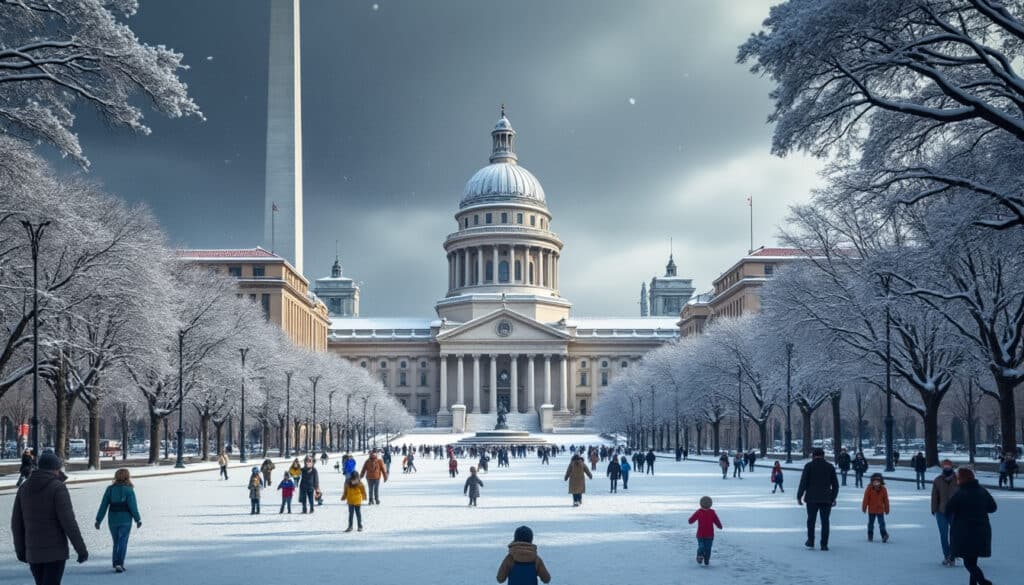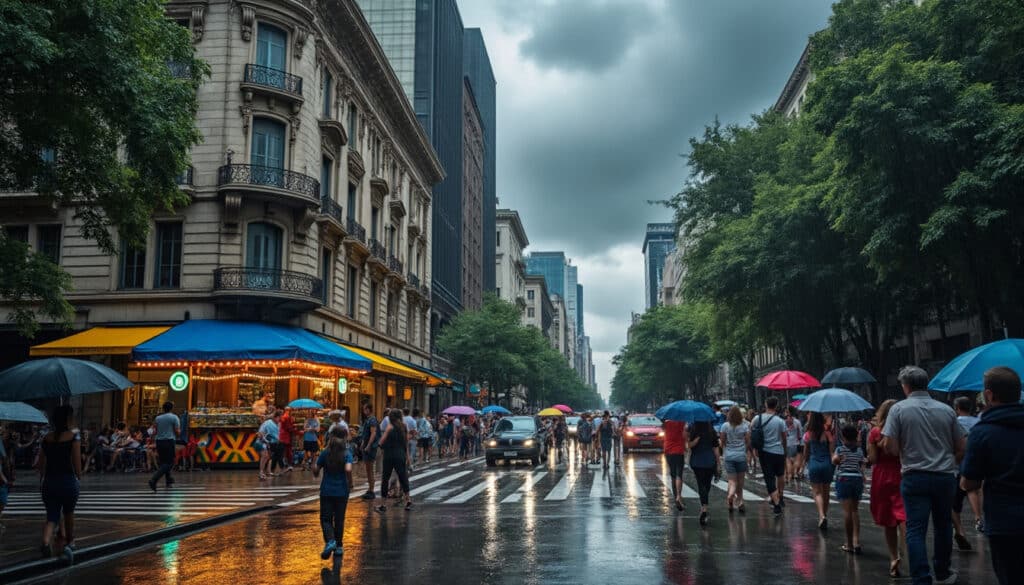Buenos Aires, the bustling capital of Argentina, with its lively tango rhythms and vibrant culture, poses a climate allure just as engaging as its colorful streets. As one of South America’s popular tourist destinations, understanding the city’s weather patterns remains essential for both visitors and locals. Does Buenos Aires maintain its warmth all year long, or does it reveal a temperament as moody as an Argentinian tango? Let’s delve into the specifics of its climate.
The Warm Embrace of Buenos Aires Summers
Every year, from December to February, Buenos Aires invites visitors to bask in its summer warmth. Summers in this city are characterized by high temperatures that often reach between 82°F to 90°F during the day. Nighttime offers mild relief, with temperatures ranging from 64°F to 72°F. For those planning their South America travel during these months, it’s not just sunbathing weather; it’s a chance to sip on refreshing mate by the riverside or enjoy a vibrant street festival under the open sky.
- 🌞 Daytime highs: 28°C to 32°C
- 🌜 Nighttime lows: 18°C to 22°C
- 🌧️ Average rainfall: 3.8 to 4.7 inches
It’s notable that summer coincides with the height of the rainy season. Regular showers and thunderstorms are common, enriching the air with a refreshing coolness before the sun heats it up again. Despite the rain, this season is far from dreary. Festivals such as the Buenos Aires Carnival paint the town in vibrant colors and rhythmic beats, drawing locals and tourists alike into the spirited celebrations.
High humidity levels during this period might seem daunting, but they are part and parcel of Buenos Aires’ subtropical character. Handy tips for travelers include wearing light, breathable fabrics and staying hydrated to fully enjoy the city’s rich offerings. From cultural events to lazy siestas in the numerous parks, summer in Buenos Aires is a time of dynamic contrasts and sensory abundance.
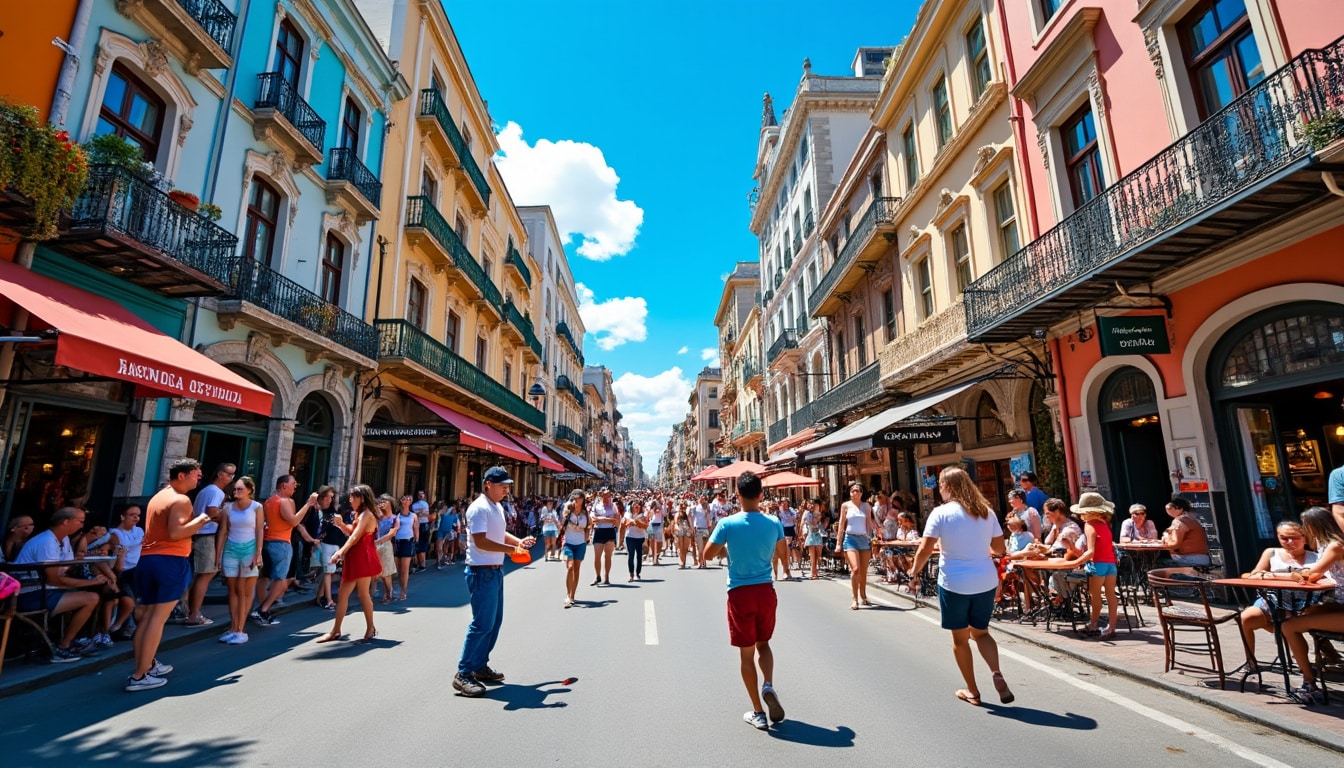
Managing Summer Showers 🌧️
The rain, though frequent, generally does not last long, allowing for plenty of outdoor activities. However, it’s wise to carry an umbrella or a light raincoat. The beauty of Buenos Aires’ weather lies in its unpredictability, making it exciting for travel enthusiasts who appreciate spontaneity. Whether it’s a sudden shower turning into a cozy café visit or a sunny spell brightening up an afternoon tango class, the city’s summer weather sets the stage for memorable cultural experiences.
Autumn’s Refreshing Transition 🍁
March to May marks the arrival of autumn in Buenos Aires, bringing a soothing break from the summer heat. This season introduces milder temperatures ranging from 51°F to 72°F, making it ideal for exploring the city’s extensive outdoor attractions and architectural marvels. The decrease in tourists during this period often results in lower accommodation prices and a more relaxed pace to enjoy the city’s splendor.
- 🍂 Average highs: 20°C to 25°C
- 🍂 Average lows: 10°C to 15°C
- 🌧️ Precipitation: 2 to 3 inches
Autumn is also the time when Buenos Aires dresses up in the vibrant colors of the season. The blooming jacaranda trees line the streets with purple blossoms, creating picturesque views that adorn postcards. The pleasant weather draws locals to engage in outdoor activities like strolling through the Caminito street museum or enjoying open-air performances at the many plazas.
This season also heralds cultural festivities such as the Buenos Aires International Book Fair and jazz festivals, alluring lovers of arts and literature from around the world. For those wishing to delve into Argentina’s rich literary heritage or be serenaded by soulful tunes, autumn offers ample opportunities without the summer’s frenzied crowds.
Travel Tips for Fall Visitors 📚
Autumn travelers should be prepared for unpredictable weather changes. Layering is key as mornings can be crisp, while afternoons could become pleasantly warm. This season is perfect for those who wish to explore Buenos Aires’ extensive parklands or venture to nearby towns enriched with historical allure.
Winter: Embrace the Off-Season Chill ❄️
From June through August, Buenos Aires experiences winter, offering a stark contrast to its summer warmth. Despite being the coldest season, with temperatures averaging between 46°F and 59°F, snow is a rarity. Known for its mild winters, Buenos Aires becomes a charming retreat for those still wishing to enjoy the city’s rich culture without the oppressive heat.
- ❄️ Average highs: 10°C to 14°C
- ❄️ Average lows: 7°C to 11°C
- 🌧️ Rainfall: around 2 inches
The tranquility of winter in Buenos Aires makes it a perfect time for indoor activities like visiting the city’s renowned museums or cozying up in a tango club. The streets may not be bustling like in warmer months, but the city’s cultural heartbeat continues to pulsate rhythmically across its historic quarters and bohemian cafes.
Though snowfall is virtually non-existent, the season does have its chilly charm. Tourists can indulge in warm pastries and hot chocolate at traditional cafes or partake in local winter festivities that bring people together, much like the warmth exuded by the city’s spirited residents.
Essential Winter Experiences 🍷
Winter is the best season for wine tasting tours in Argentina. Visitors can venture into nearby wine regions, sampling world-renowned Malbecs while enjoying the scenic landscapes. Additionally, winter is the perfect time to indulge in hearty Argentinian cuisines, with dishes like “locro” or “asado” that warm the soul.
Spring: Nature Awakens in Buenos Aires 🌸
Spring breathes a fresh lease of life into Buenos Aires from September to November. The city transforms as flowers bloom and temperatures rise comfortably, making it ideal for both cultural exploration and recreational activities. With average temperatures ranging from 56°F to 75°F, it’s no wonder that tourists find springtime particularly enchanting.
- 🌸 Average highs: 18°C to 24°C
- 🌸 Average lows: 13°C to 18°C
- 🌧️ Rainfall: 3 to 4 inches
Spring is a great season to visit Buenos Aires’ outdoor attractions such as the Botanical Gardens or take a leisurely boat ride along the Tigre Delta, experiencing the city’s lush flora and vibrant street artists at play. Tourists can relish walks through Buenos Aires’ historic streets or picnic under the springtime sun.
This season juggles warm sunny days with periodic rainfall, but neither dampens the lively atmosphere. The streets pulsate with dance and music, while art galleries and craft shops throw open their doors to showcase the creativity that defines this resilient city. Whether you’re a fan of culinary delights or cultural showcases, spring in Buenos Aires promises to enrapture the senses.
Must-See Spring Attractions 🌼
One should not miss the lively events such as the Buenos Aires International Festival of Independent Cinema, which attracts filmmakers and enthusiasts from all over the world. The ever-popular jacaranda trees, blooming in full splendor, create beautiful backdrops for city exploration or a relaxing afternoon at a cafe.
The Essential Takeaway on Buenos Aires’ Climate
Buenos Aires’ climate can be described as a vibrant tapestry of fluctuating conditions, much like its culture. With each season offering unique experiences, planning based on climate data ensures visitors maximize their time in this captivating city. For more detailed climate and weather statistics, Buenos Aires Trip provides comprehensive travel guides and current weather services to help tailor your Argentinian adventure.
- 📆 Best times to visit: Spring and Fall for mild weather
- 🎉 Must-attend events: Jazz Festival in Autumn, Carnival in Summer
- 💧 Prepare for rain: Umbrella and raincoat in summer
- 🧤 Dress smartly: Layering in Autumn, warm clothing in Winter
Whether you’re seeking the warmth of the summer or the cool comfort of winter, Buenos Aires provides a rich adventure awaiting eager travelers. Understanding its unique climate helps tailor your travel guides for a seamless encounter with all the city has to offer.
FAQ: Buenos Aires Climate
- Is Buenos Aires warm all year round?
Buenos Aires experiences hot summers and mild winters, so it’s generally warm from December to February and cooler from June to August.
- When is the rainy season in Buenos Aires?
The rainy season peaks in the summer months, particularly from December to February, but rainfall is relatively consistent throughout the year.
- Does Buenos Aires ever experience snow?
Snow is rare in Buenos Aires. The last significant snowfall occurred in 2007. Winters are generally mild.
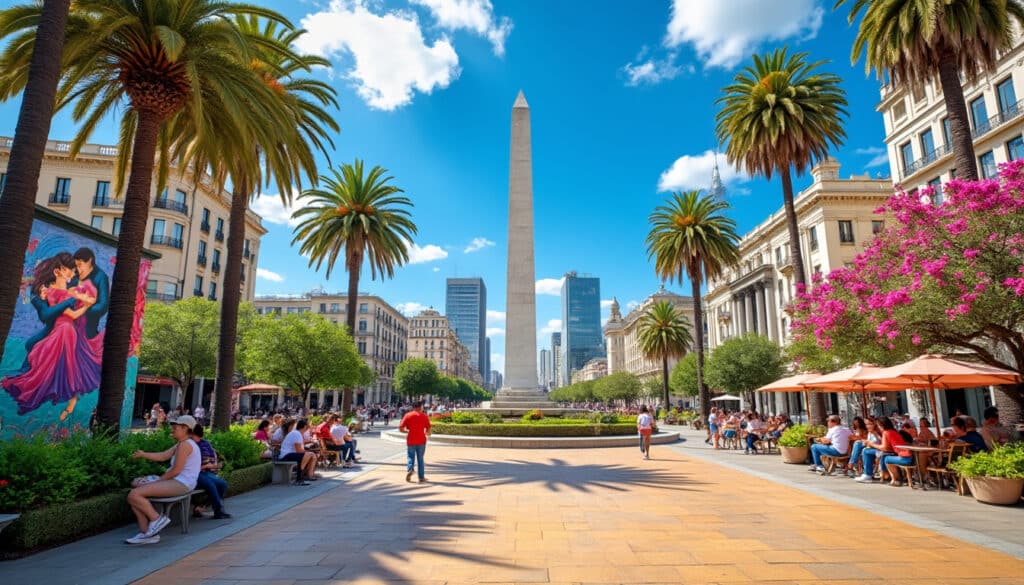
Climate & Weather in Buenos Aires
The mesmerizing city of Buenos Aires, where the tango rhythms and historic architecture intertwine, offers a climate as multifaceted as its vibrant culture. As Argentina’s bustling capital, it entices travelers year-round with a warm, humid subtropical climate. Visitors wander through…
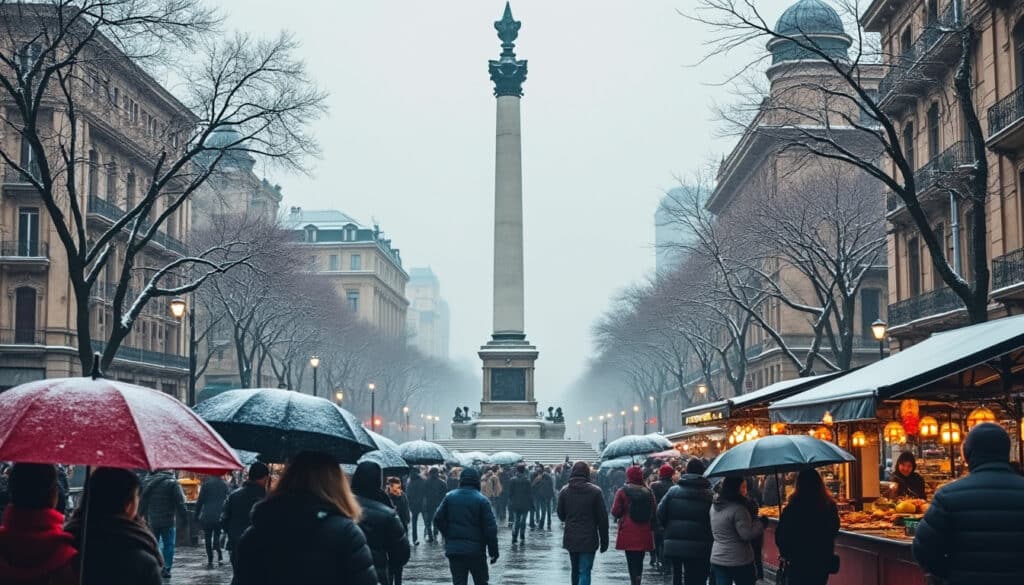
When thinking about Buenos Aires, images of vibrant tango, bustling streets, and warm climates might come to mind. However, the story of Buenos Aires includes the lesser-known cold weather that grips this fascinating city during the winter months. This unique…

Flooding and natural risks in Buenos Aires
Buenos Aires, a city known for its vibrant culture and bustling streets, faces significant challenges from natural risks, particularly flooding. As climate patterns shift and urban areas expand, the frequency and intensity of these occurrences have escalated, affecting both the…
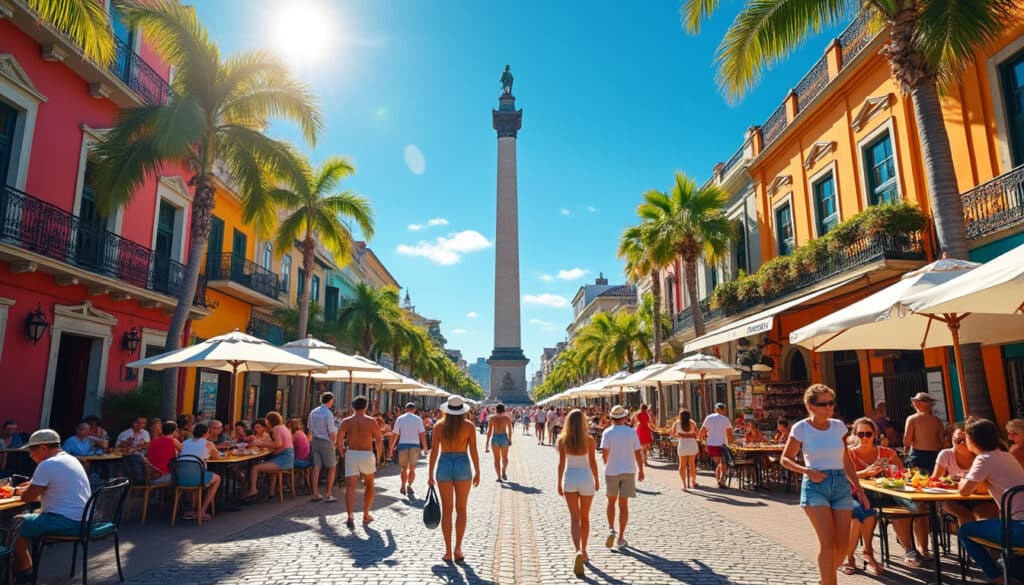
The vibrant city of Buenos Aires is not only famous for its tango beats and cultural richness but also for its unique weather patterns that shape the life of its residents and captivate the imagination of visitors. As we step…
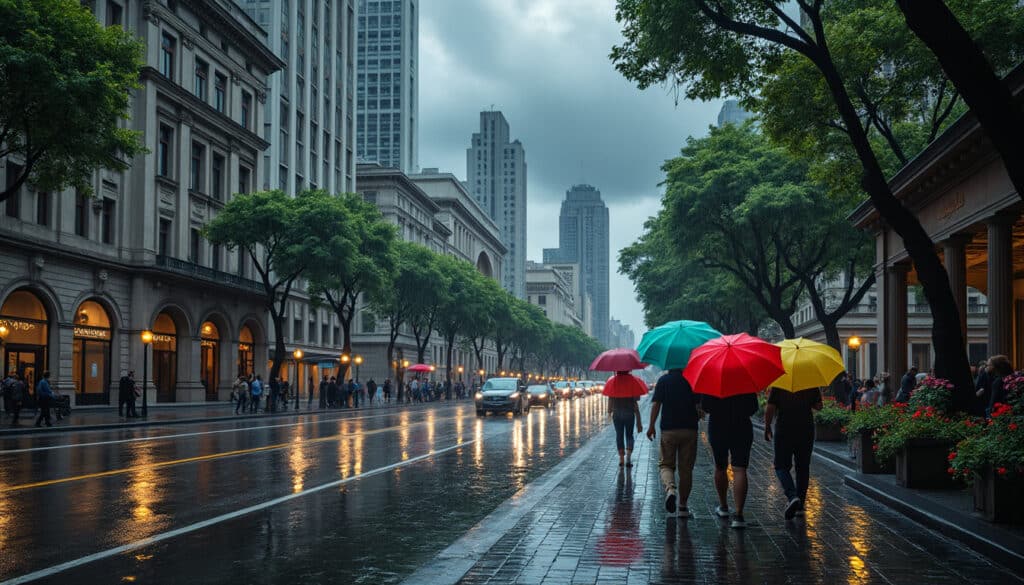
Rain and precipitation in Buenos Aires
Buenos Aires, a bustling metropolis known for its vibrant culture, tango music, and exquisite cuisine, experiences a complex and diverse climate that might surprise both residents and tourists. This city, located on the southeastern coast of South America, is graced…
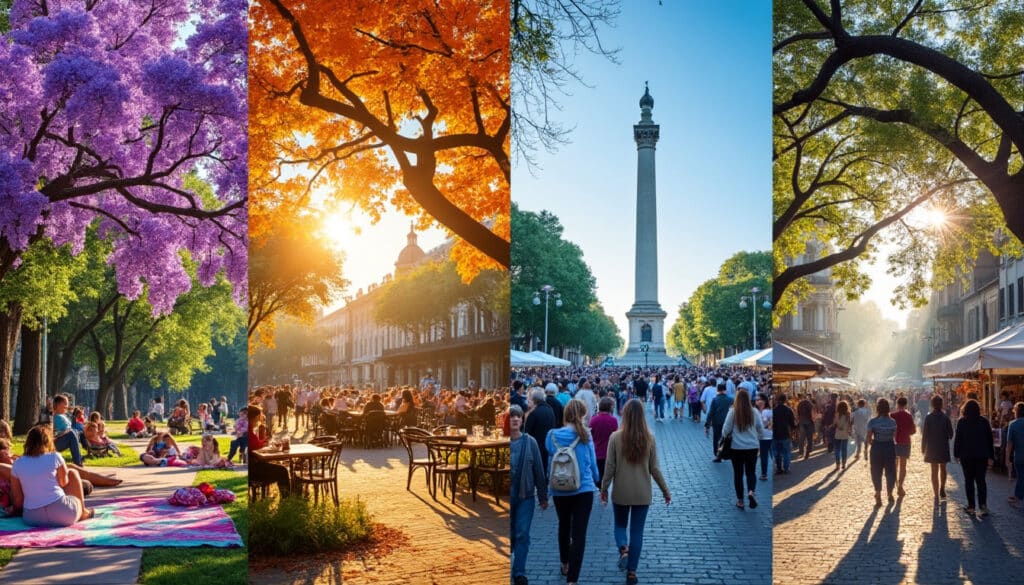
Buenos Aires, the vibrant capital of Argentina, offers a dynamic climate that enriches both the lives of its residents and the experience of its many visitors. Throughout the year, the city experiences a range of weather patterns that mirror the…
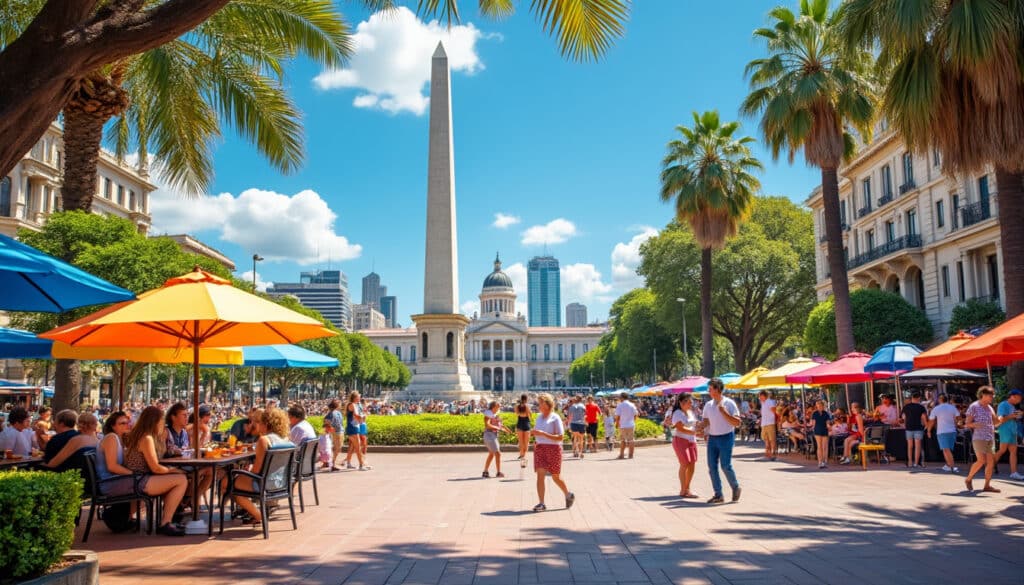
Buenos Aires, the vibrant heart of Argentina, is a city where the rhythm of tango dances in harmony with the ebb and flow of its varied climate. The city’s temperatures are a fascinating dance between the warmth of summer sun…
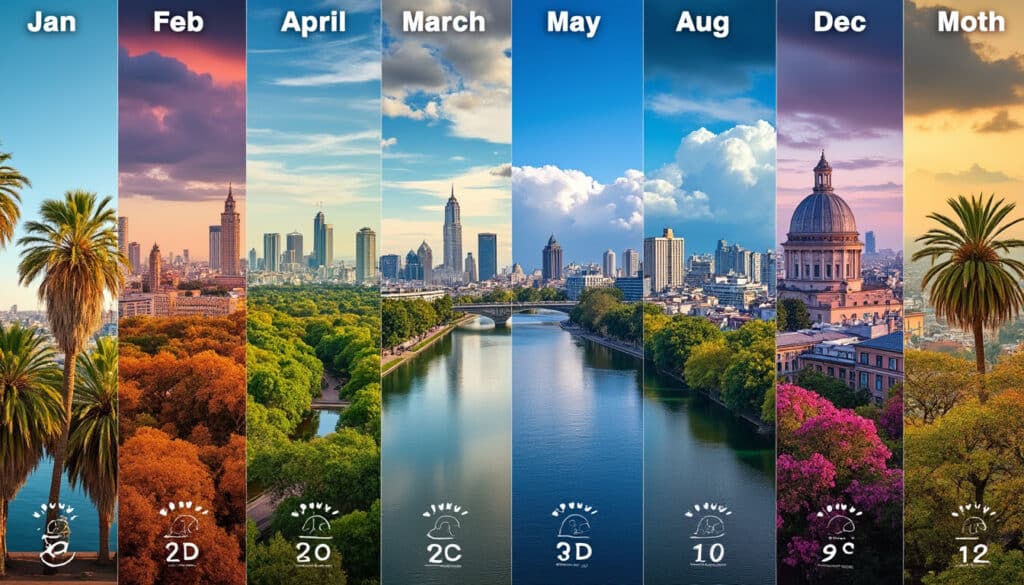
Weather in Buenos Aires by month
Buenos Aires, with its rich tango culture and vibrant city life, offers a distinct climate experience throughout the year. The city’s weather varies significantly between the warm, humid summers and the mild, fog-kissed winters. Understanding Buenos Aires’ weather patterns can…

What is the weather like in Buenos Aires?
Buenos Aires, known for its vibrant culture and lively atmosphere, boasts a weather pattern that is as varied as the tango rhythms that echo through its streets. Travelers arriving in the city are often greeted by a climate that is…


